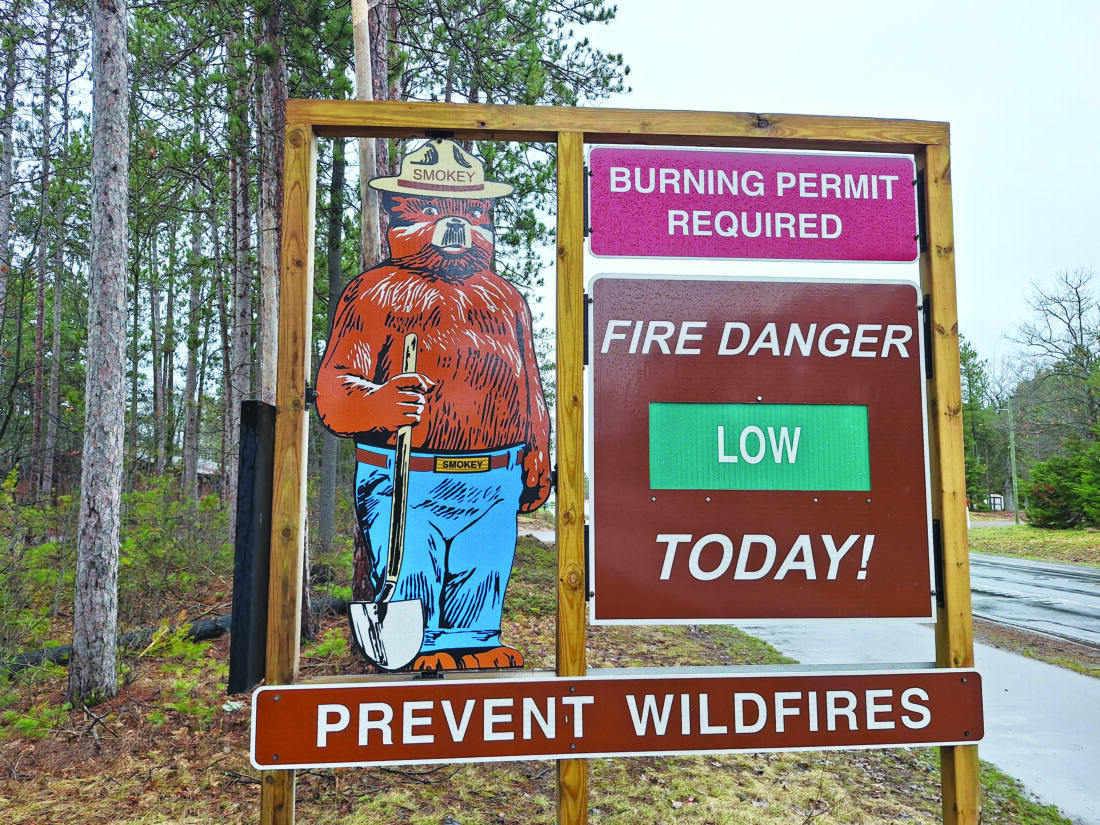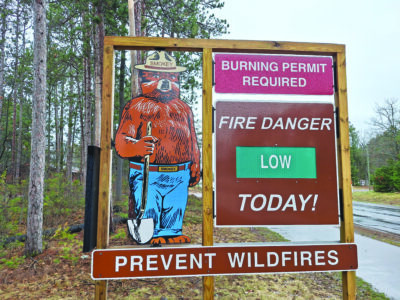Only you can prevent …
May is national Wildfire Awareness Month

Ben Garbacz/Daily Mining Gazette The image of Smokey Bear, outside the Baraga DNR office, relates the fire danger on any given day.
HOUGHTON — May is national Wildfire Awareness Month and during this time and authorities say Copper Country residents should familiarize themselves with what leads to wildfires and what can help prevent them. There are two times of the year which are common for wildfire seasons in the Upper Peninsula: spring and late summer.
Low humidity, high temperatures and strong winds, when occurring simultaneously, create prime conditions for an ignition to begin a wildfire, which firefighters and the National Weather Service refer to as red flag warnings. The intensity of a wildfire is determined by the type of vegetation it consumes and its health. Dry grasses and pine trees will burn faster than lush leafy trees.
Before flora returns at the peak of spring, the decayed and withered plants from last fall provide kindling for wildfires to begin. The late summer presents opportunities for wildfires from strong summer thunderstorms bringing wind and lightning, and a common ingredient in wildfires, people.
Michigan DNR Deputy Public Information Officer John Pepin said most lighting strikes do not result in immediate ignition. “It can strike a tree and smolder for two or three days before it actually ignites surrounding vegetation and such,” he explained. “So we often see delays in lightning fires.”
A more common source for the start of a fire is people. Summer brings about the camping season for locals and tourists alike, and the heightened amount of people in forests creating campfires, as well as residents burning debris, heightens the risk of ignitions. Unwary campers are not the only instigators however, as things like sparks from trains and outdoor equipment, discarded smoldering cigarettes or cigars and arson can contribute to wildfires.
According to the DNR’s Fire Report Dashboard, in the last 10 years the greatest causes of fires in Michigan were debris burning with 1,730 fires, equipment with 749 fires, undetermined causes creating 599 fires, miscellaneous reasons leading to 584 fires and campfires resulting in 528 fires.
When it comes to taking preventative measures to minimize the chances of starting a wildfire, Pepin recommends visiting the Michigan DNR website Michigan.gov/firemanagement for resources. The website presents information in regards to obtaining burning permits and if a burning is permissible on a particular day. The site also provides fire safety tips and information on prescribed fires fire experts conduct to remove natural materials that act as fuel for larger wildfires, improve wildlife habitat and fight invasive species.
When someone is enjoying time around a campfire, it is important to never leave it unattended and make sure dead or dry vegetation is not close by. A water source should always be accessible to extinguish the fire if it begins to behave uncontrollably, and always use water to put out the fire even if only smoldering. After applying water, stir the ashes and repeat the process until no more heat is coming from the fire pit.
Fires should never be lit when it is windy or vegetation is overall dry. The National Weather Service can be consulted on its website to see if red flag warnings are in effect. If a fire is seen in the wilderness, people need to dial 911 or if a signal is unavailable they need to contact the nearest park authorities or first responders in person. Pepin said non-firefighters should not try to attempt to fight a fire and get to safety instead.
“Wildfires in the springtime in the Upper Peninsula are a common thing, and it’s something that we have to plan for,” Pepin said. “And the safer people are, the more mindful that they are of how fires start and how they can prevent fires from starting or spreading, the fewer the risks are going to be to people and property and natural resources.”





